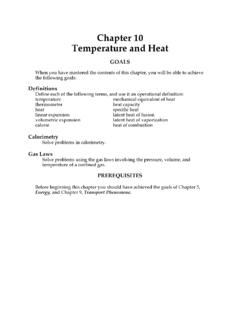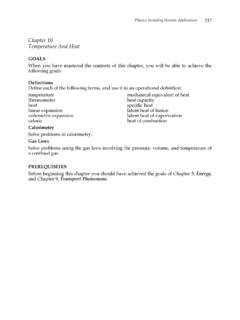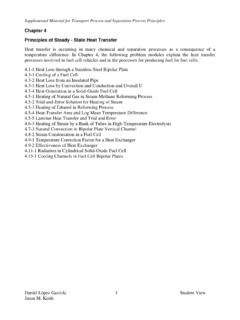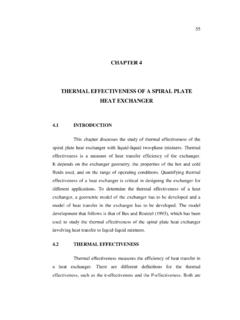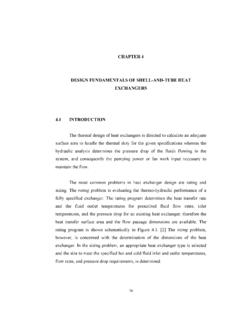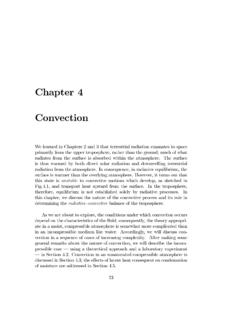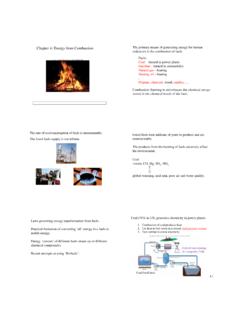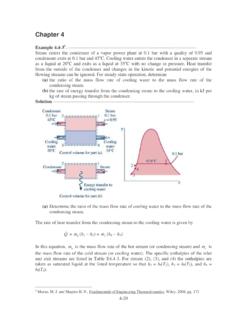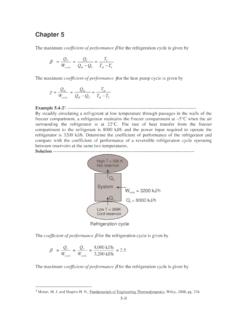Transcription of Chapter 4 Heat Review - Mr. Palmarin's Class Website
1 Name: _____ Chapter 4 heat Review Physics Portion: Section 1: Temperature Conversions (reference your notes for the conversion formulas) 1. Convert the following. a) 32 C into F b) -54 F into K c) 112 K into C d) 212 K into F Section 2: Thermal Expansion = 2. The longest continuous bridge in Saskatchewan is a 380 m long steel bridge in North Battleford. The temperature in the area varies from -40 C to 30 C. What is the change in length of the bridge if the coefficient of linear expansion of steel is 12 x 10-6 C-1? 3. A piece of aluminum house siding is m long on a cold winter day (-28 C). How much longer is it on a very hot summer day (39 C)? The coefficient of linear expansion of aluminum is 25 x 10-6 C-1.
2 4. m long steel rails were laid on a day when the temperature was C. What gap should have been left between the rails for the maximum recorded temperature of 36 C? Coefficient of linear expansion of steel is 12 x 10-6 C-1. Section 3: Specific heat Capacity Q = mC T 5. How much heat is absorbed by a kg piece of glass if it is heated from 98 C to 210 C? [C = 664 J/(kg C)] 6. When 2 kg of iron is cooled from 80 C to 15 C, it releases 58500 J of heat . What is the specific heat capacity? 7. If a mass of aluminum takes 108kJ of heat to raise the temperature from 10 C to 50 C, what is the mass of the aluminum? Section 4: Transfer of heat Energy = , !
3 , ! 8. Determine the final temperature of the system if piece of brass at 132 C is placed into a container that contains of water at 20 C. [C (water) = 4180 J/(kg C)] [C (brass) = 376 J/(kg C)] 9. A sample of water is at C. A block of zinc is placed in the water. If the final temperature of the water is C, determine the original temperature of the piece of zinc. [C (water) = 4180 J/(kg C)] [C (zinc) = 388 J/(kg C)] Section 5: Specific Latent heat of Fusion & Vapourization Q = m Hf and Q = m Hv For the questions below, use: C (water) = 4180 J/(kg C), C (ice) = 2060 J/(kg C), C (steam) = 2020 J/(kg C)] 10. A g sample of water at 60 C is heated to steam at C.
4 How much heat is transferred? (This is 3 steps). 2H2 + O2 2H2O 11. Calculate the quantity of heat required to change 50g of ice at -10 C into steam at 120 C. (This is 5 steps). 12. Calculate the quantity of heat required to change 100g of steam at 130 C into ice at -10 C? (This is 5 steps). Note: Change the sign of Hv and Hf. Chemistry Portion: Section 6: Endothermic and Exothermic Reactions & heat of Formation 1. Identify the following reactions as exothermic or endothermic and re-write them as thermochemical equations. a. 6 FeCl3(s) + 173 kJ ! 6 FeCl2(s) + 3 Cl2(g) b. 2 H2O(g) + 2SO2 (g) + 520 kJ ! 2 H2S(g) + 3 O2 (g) c. 4 NH3 (g) + 5 O2 (g) ! 4 NO(g) + 6H2O(l) + 1170 kJ 2.
5 Use the enthalpy diagram below to answer the following questions: a. Is this an endothermic or exothermic reaction? b. What is the heat of this reaction, H? c. Write out a balanced thermochemical equation for the above reaction. d. Using the above reaction as a starting point, determine how much energy would result if 7 mol of H2 reacted. 3. The H for the complete combustion of 1 mol of propane (C3H8) is x 103 kJ. Calculate the heat of reaction for the combustion of g of propane. 4. Calculate the heat of reaction, H, for the following reactions. [Use your Table of H f] Use H = H f (products) - H f (reactants) a. 2 SO3 (g) ! 2 SO2 (g) + O2 (g) b. 2 C2H6 (g) + 7 O2 (g) !
6 4 CO2 (g) + 6 H2O (l) c. Fe2O3 (s) + 2 Al (s) ! Al2O3 (s) + 2 Fe(s) d. NO (g) + O3 (g) ! NO2 (g) + O2 (g) Potential Energy kJ 30 25 20 15 10 5

